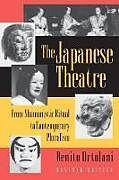The Japanese Theatre
Einband:
Kartonierter Einband
EAN:
9780691043333
Untertitel:
From Shamanistic Ritual to Contemporary Pluralism - Revised Edition
Autor:
Benito Ortolani
Herausgeber:
Princeton University Press
Auflage:
Revised Edition
Anzahl Seiten:
426
Erscheinungsdatum:
09.03.1995
ISBN:
0691043337
"The book represents the summation of a lifetime's work by a meticulous teacher and scholar whose fascination with his subject now allows him to share his knowledge, and his enthusiasms, with a larger audience."---J. Thomas Rimer, Asian Theatre Journal
Autorentext
Benito Ortolani
Klappentext
Widely recognized as the standard history of Japanese theatre for Western readers, this work by Benito Ortolani is now available for the first time in paperback. From ancient folk and ritual performances to modern dance theatre, it provides concise summaries about each major theatrical form, situating the genre in its particular social, political, and cultural contexts and integrating a vast array of detail on such topics as staging, costuming, masks and properties, repertory, acting techniques, and noteworthy actors. Complete with illustrations and an extensive bibliography, this book serves undergraduates and specialists both as a reference and as a cultural history of Japan seen from the perspective of the performing arts.
Zusammenfassung
Offers a history of Japanese theatre. From ancient folk and ritual performances to modern dance theatre, this book provides summaries about each major theatrical form, situating the genre in its particular social, political, and cultural contexts and integrating a vast array of detail on such topics as staging, costuming, and more.
Inhalt
Preface to the Revised Edition Introduction Periods in Japanese History Ch. I. The Beginnings Jomon Period (-ca. 250 B.C.) Yayoi Period (ca. 250 B.C.-ca. 300 A.D.) Kofun Period (ca. 300 A.D.-710 A.D.) The Haniwa Kojiki and Nihongi (Eighth Century) Uzume's Trance Umisachi's Pantomime Utagaki "Indigenous" versus "Imported" Ch. II. Kagura The Word Kagura Use of the Name Kagura Division of Kagura Mikagura Satokagura Ch. III. Gigaku History Contents and Style Controversy about the Origins Survival of Gigaku Ch. IV. Bugaku The Words Bugaku and Gagaku History of Gagaku and Bugaku Division of Bugaku Historical Outline of Bugaku Dances Bugaku Costumes Bugaku Masks Bugaku Props Musical Instruments The Bugaku Stage Ch. V. Theatrical Arts in the Ninth to the Thirteenth Century The Words No, Kyogen, Nogaku The Sangaku and Sarugaku Traditions The Words Sangaku and Sarugaku Relation between Sangaku and Sarugaku Heian Shin Sarugaku in Performance The Shushi Sarugaku The Okina Sarugaku The Furyu Tradition The Ennen Tradition The Dengaku Tradition The Shugen Tradition Kusemai, Shirabyoshi, Ko-uta and Rambu Social Position of the Performers Ch. VI. Nogaku Theories on the Origins of No History of Nogaku Zeami's Secret Tradition of the No Basic Concepts of Zeami's Aesthetics Zenchiku's Theories on the No The No Plays The Performance of No The No Stage Costumes, Props, and Masks Kyogen: A New Perspective The Theories of Okura Toraaki Classification of Kyogen Plays The Performance of Kyogen Mystery Plays and School Theatre of the Jesuits Ch. VII. Kabuki Background of Kabuki and Joruri History of Kabuki: An Overview Kabuki in Performance Costumes and Make-up Theatre Buildings, Stage, and Decor Kabuki and Joruri Playwrights Kabuki Juhachiban Geidan: Actors' Memoirs Ch. VIII. The Puppet Theatre The Words Joruri and Bunraku History of Joruri Bunraku after the Meiji Restoration The Stage Bunraku Aesthetics Ch. IX. The Modern Theatre: Shimpa Origins of the Shimpa Movement: Sudo Sadanori Kawakami Otojiro Seibikan and Other Companies The Golden Age of Shimpa The Decadence of Shimpa Shimpa from World War II Ch. X. Shingeki: The New Drama The Period of Trial Plays (1906-1913) The Period of Commercialization (1914-1923) The Early Tsukiji Little Theatre Movement (1924-1927) The Leftist Propaganda Plays (1928-1932) The Artistic Period (1933-1940) Shingeki after World War II (1944-1994) The Underground Theatre Movement (1960-1985) Ch. XI. Modern Music and Dance Theatre Opera The Takarazuka Revue Company Revue, Operetta, Miscellaneous Entertainments Buto and the Phenomenon of Circularity Ch. XII. History of Western Research on the Japanese Theatre From Mid-Sixteenth to Mid-Nineteenth Century From Mid-Nineteenth Century to Showa The Showa Period to the End of World War II Following World War II Japanese Contributions to Western Languages Glossary Bibliography Index

Leider konnten wir für diesen Artikel keine Preise ermitteln ...
billigbuch.ch sucht jetzt für Sie die besten Angebote ...
Die aktuellen Verkaufspreise von 6 Onlineshops werden in Realtime abgefragt.
Sie können das gewünschte Produkt anschliessend direkt beim Anbieter Ihrer Wahl bestellen.
Loading...
Die aktuellen Verkaufspreise von 6 Onlineshops werden in Realtime abgefragt.
Sie können das gewünschte Produkt anschliessend direkt beim Anbieter Ihrer Wahl bestellen.
| # | Onlineshop | Preis CHF | Versand CHF | Total CHF | ||
|---|---|---|---|---|---|---|
| 1 | Seller | 0.00 | 0.00 | 0.00 |
